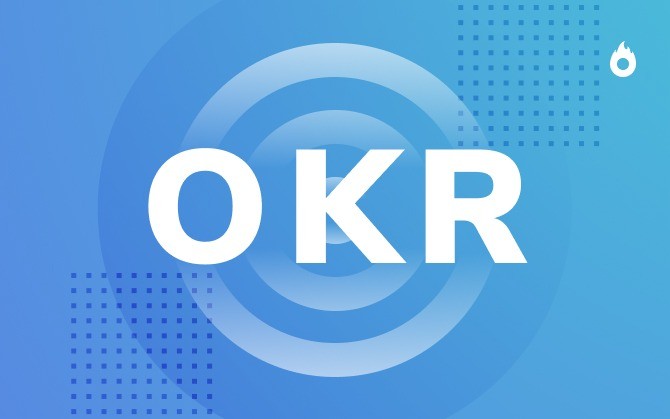
OKR: How to Manage Your Project’s Objectives and Key Results
How to apply the OKR methodology in real life to achieve outstanding results

What will we see in this post
Do you know that feeling that you should be measuring the results of your project better and you are missing some important information? Well, you should probably know that one of the ways to do that is using OKRs, objective and key results.
The OKR (Objective and Key Results) method became popular starting in 1999 by Google and its use became widespread with the growth of search startups. Currently, the method is well known in the market, and it is applied by various companies such as Twitter, Spotify, and LinkedIn, among others.
Objective and key results (OKR) are used to manage any kind of business indicator. The method can be applied by digital businesses, agencies, and individual entrepreneurs and can be very useful in your day-to-day activities.
If you wish to measure your results efficiently, check out what we have prepared for you to read in this article.
What are objective and key results (OKR)?
OKR is a method of setting goals intended to guide the actions carried out in a project while focusing on objectives that aim to achieve results that are measurable.
Simply put, we follow the formula below to set the goals:
I’m going to [objective], measured by [SUM of key results].
An example…
I’m going to improve my students’ engagement measured by a 60% to 90% increase in the number of students who complete my course.
Now that you know what the objective and key results are, it is important to learn why you should use it, right?
Why use Objective and Key Results (OKR)?
According to Marty Cagan, if he had to choose only one reason why most projects fail, he would blame focusing on complying with deliveries.
80% of initiatives focused on deliveries do not have any impact on the results.
Planning to complete tasks as goals for your project makes it so that the success of a goal be summarized into a delivery.
Unlike this way of thinking, objective and key results (OKR) are a result-oriented tool in which the factor of success of a goal is aligned to the achieved result and not on the actual delivery of a task.
However, it is important to analyze the maturity of your product and determine if this is the ideal time to be guided only by results.
Check out the map below, which defines when your business should use the methodology to guide its objectives and results:
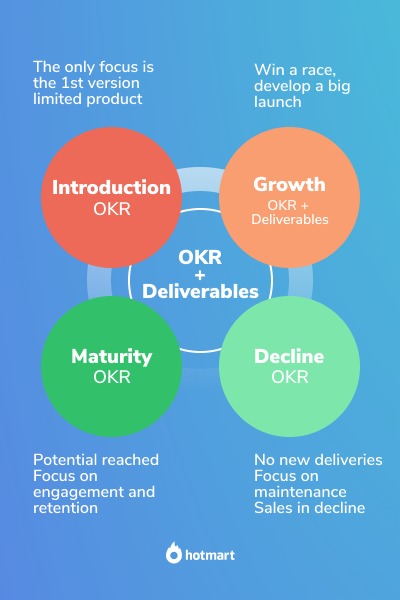
Regardless of the current circumstances, your business is going through, using OKRs, these are the main benefits offered by the method:
- Lessons will be learned in one quarter
It becomes more tangible and allows you to quickly correct any mistakes. - A clear and simple definition
That is the basis for generating high team engagement. - Results are measured on a weekly basis
This allows you to anticipate mistakes. - Prioritizes transparency of your objectives
All team members are aware of the company’s OKRs. - Reinforce the data-driven culture
Decision-making based on data. - Measure the results instead of effort
Dedication alone is not enough to reach the objectives.
Are you convinced that this is the right time for your project to be guided by results? Then let’s move on to the next step.
How to set an Objective and Key Results
The definition of OKRs is simple, which makes it easier for understanding the goals and their applicability. However, you must pay attention to small details to avoid mistakes and to ensure that the applied effort generates the expected results.
The first step is to clearly understand what is the role of an objective and a key result:
Objectives
Objectives are concise statements of the direction the business wishes to follow so that people are able to imagine how important it is to reach it;
Key results
The results define the milestones that will have a direct impact on reaching the objective if it is carried out successfully.
Example:
O – Provide an experience that keeps students engaged
KR1 – Increase, from 20% to 30%, the number of students who reach module 2 in less than 7 days.
KR2 – Increase, from 10% to 30%, the number of students who complete the course within 3 months.
In summary, the objective is where we want to arrive and the key outcome is how we measure whether the objective was reached.
The image below provides a visual explanation of how it is organized:

Now that you understand the method structure, let’s see the details that make the difference!
How to set Objectives (O)
Setting the company’s objectives
The company’s OKRs are set by management and are typically valid for one year — but you can also use OKR software.
It is important to emphasize that OKRs are great learning tools. Bonuses and performance should not be assessed through the fulfillment of KRs.
Not all objectives will meet the financial goals of revenue and profit alone. Therefore, objectives should be treated alongside financial growth.
This allows more objectives to be established concurrently, without making all individuals involved feel intimidated if they are not able to reach them.
The objective is a guide that steers the future of the business. Based on this alignment, the objectives of each team must be set.
Setting the team’s objectives
Based on the company’s priorities, the leaders of each team must refine the objectives that will contribute to the overall objective.
This alignment must move in the same direction as the global objectives.
It is at this stage that many teams make mistakes…
Case 1
A company’s commercial team has two sub-departments: marketing and sales.
The company establishes that the objective of the marketing team is to increase the number of leads generated. Meanwhile, the objective of the sales team is to increase the conversion rate.
Impact
The problem is that the members of these sub-departments work in the same team – Commercial – which generates conflict over what the team should really focus on, because one goal could negatively affect the other.
Therefore, it is crucial that the OKRs are not defined in the various organizations of small teams or products, but rather in the team vision as a whole.
Case 2
Another mistake many companies make is to delegate to their own teams the responsibility to set their objectives.
Impact
This seems positive in terms of autonomy but is detrimental with respect to the business direction. Leaders must establish the objectives each team should strive to reach.
(Note: the objectives, not the key results.)
After all, the leaders are in a privileged position to evaluate which objectives generate more value for the business.
All done
Once the objectives are clearly established, it’s time to define the KRs…
VIDEO: 4 Lessons Learned after Millions in Launches | Erico Rocha at Hotmart MASTERS
How to define key results (KRs)
Key results should be defined based on the objectives set for each team. Each team must define how they will measure whether their objectives have been reached.
For this reason, the KR can’t be difficult to measure during follow-up.
If you need to access a database, extract files, import and create multiple tables, or use complex formulas to reach the figures, that is a sign that you should improve the definition of your KR.
Hence the importance of simplicity. This will allow easy and clear follow-up for the entire team. Speaking of follow-up…
Follow-up should be done on a weekly basis, and you should reevaluate the indicators if your metrics are too complex.
A tip to avoid frustrations among team members is to have a single KR for the objective under the”all or nothing” mode.
In this sense, adding other KRs to boost learning among team members faced with the challenge could be an opportunity to refine the process.
It seems easy, doesn’t it? And it actually is, but it is important to pay attention to slips and falls…
Case 1
Define KRs based on deliveries, not on results.
Example: deliver the XYZ functionality to all customers.
Impact
When we define OKRs, it is common that we still need to figure out the solution to reach the objective. It requires researching and testing, along with following up on the results.
Researching and testing mean that we still don’t know the answer to the problem.
Therefore, never focus on what will be delivered, but rather on the business objectives.
Case 2
KRs can be responsible for making the team lose motivation.
It is common to define KRs as “all or nothing”, with unreachable and very bold goals.
Impact
The motivation of a team that needs to deliver a 1% improvement will be very different from a team that needs to reach 40%.
If this scenario was observed during the weekly follow-up, it is important to make clear to the team that reached the goal partially will be celebrated. After that, these figures should be refined for the next goal.
This is why OKRs should not be used as a metric of individual performance. If this happens, the teams will only accept setting conservative KRs that they are sure can be reached.
Case 3
We want to make X delivery, so we can set a metric that will be impacted by this delivery, so we defined this indicator as a KR.
Impact
The first thing you must evaluate is whether this delivery really complies with the objective set. Remember that figuring out the solution can take place while striving to achieve the result.
One way to evaluate if you are on the right track is to think of different solutions to reach the same KR, and then assess what is the most simple and efficient way to do so.
As we mentioned earlier, the focus is always to strive to achieve results, so don’t concentrate on your ideas and deliveries!
All done
Now that you know how to set objectives and key results, many goals will emerge to lead your project towards a successful outcome, right? Right now, you need to prioritize what needs to be done, so that’s what we will be discussing next.
How to prioritize OKRs
The more your project and your team grow, the more the number of objectives and results that can be pursued concurrently. However, the old “divide and conquer” strategy must always be respected.
Therefore, it is important to define prioritization criteria that will help you select which KRs the team will attempt to reach first.
Below you can see three important factors when defining these criteria:
Impact
What impact will be generated by the objective? Even if the milestone has been reached, the objective is the finish line.
Attainability
What is the degree of simplicity when attaining this result? The greater the degree of difficulty, the higher the chances that an indicator will be attained the wrong way, or not be ascertained at all.
Influence
What is the ability to create solutions or deliveries that in fact influence the result? In some cases, the objective and the results can be properly defined, but the team responsible doesn’t have sufficient influence to generate impact.
Please note!
Know that effort is not a criterion for prioritization, because as mentioned earlier, the solution that will lead to the result has not yet been defined or discovered; therefore, you cannot measure what effort will be “applied”.
To ensure that all these actions based on the result work synchronously and seamlessly, you need to define the responsibilities and a few formal tasks, which we will discuss next.
Responsibilities and formal tasks
Despite being a simple method, aimed at clear definitions, in order to keep OKRs in full operation within a business, it is necessary to define who should undertake the responsibilities. Let’s see it.
Responsibilities
Top Down Objectives
By setting the objectives, the leadership is saying to the team that this should be their focus for the next quarter.
Bottom Up Key Results
By setting the key results, the team reports to the leadership that “this is how” they will prove that they will reach the proposed objectives.
The table below defines the role of each team member and the frequency of setting objectives and key results.
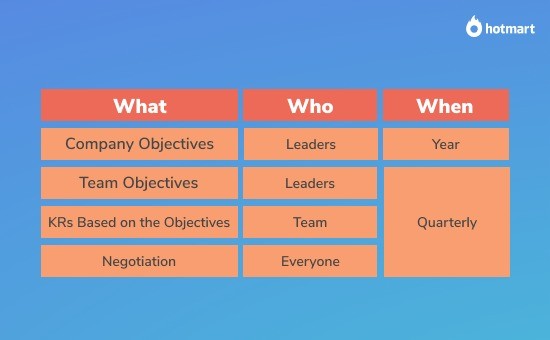
Company objectives: leadership undertakes this responsibility; usually set on an annual basis.
Team objectives: leadership undertakes this responsibility; usually set on a quarterly basis.
KRs based on objectives: the team undertakes this responsibility; must be set on a quarterly basis.
Negotiation: the entire team undertakes this responsibility; should take place on a quarterly basis.
As the responsibilities have been defined, let’s move on to the formal tasks.
Formal tasks
For smooth progress and control of objectives and results throughout the year, it is important to determine a few formal tasks, keeping the alignment of the entire team and the project.
They are:
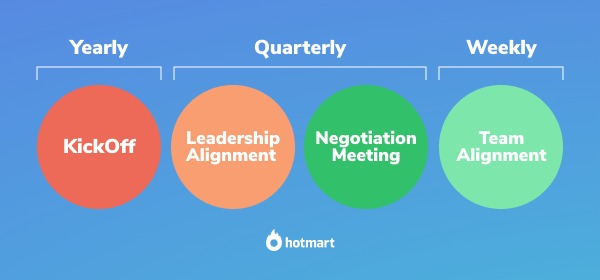
Kickoff
The Kickoff meeting is held annually and it is when the leaders present to the entire team the business objectives for the next year. It is a very important meeting to clearly explain to the team the reasons why the objectives are being set.
Leadership alignment
With the company’s objectives in hand, the leaders of each team are ready to establish the team’s objectives. This formal task should take place on a quarterly basis, before the end of each quarter, so the team has time to define and present the KRs for the next period.
Negotiation meeting
The negotiation meeting takes place between the teams and the leaders so that all KRs are presented. This meeting opens room for discussion aiming to validate that all KRs comply with the objectives, and whether the figures they are trying to reach are feasible according to the company’s potential, among other details. After this meeting, the entire team must be in agreement and committed to reaching the objectives.
Team alignment
Team alignment takes place on a weekly basis and its objective is to follow up on the progress of all KRs. This alignment allows the team to discuss whether the actions that are being implemented are producing the desired effect on the results. This alignment has a shorter frequency than the others because any deviation in the team’s progress should be noticed as soon as possible to ensure that action is taken.
Annual timeline
The image below shows how an example of an annual timeline of formal tasks related to the control of OKRs.
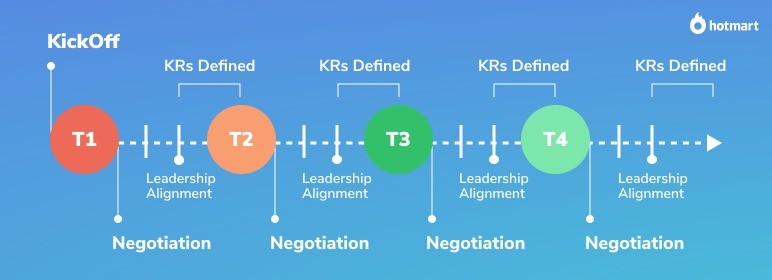
Now that you have developed a great plan, let’s talk about how to measure whether the results are being reached.
How to measure OKRs
When using OKRs, nothing will make sense if you don’t follow up on the results obtained with the team’s effort. For this reason, follow-up must be simple, yet assertive.
Specific software is available for following up on goals that facilitate the management, but a simple spreadsheet could meet all your needs. See below an example of follow-up:
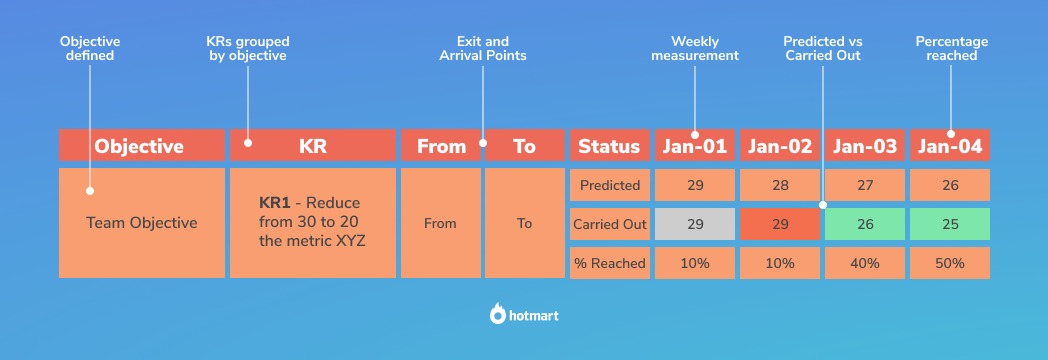
Defining a start and an endpoint for each KR is an excellent way to clarify the results. On various occasions, we work with percentages or relative values that may cause confusion or even a mistaken impression that the results are good or bad.
Another interesting point is giving a status of planned, completed, and the percentage reached so far. With these indicators, you can easily track whether the progress is below or above what is expected. This way, you can make decisions regarding the direction of your business as soon as possible, so that the objectives can be achieved.
If you like a visual follow-up, this model also allows you to define charts to track the progress of each KR.
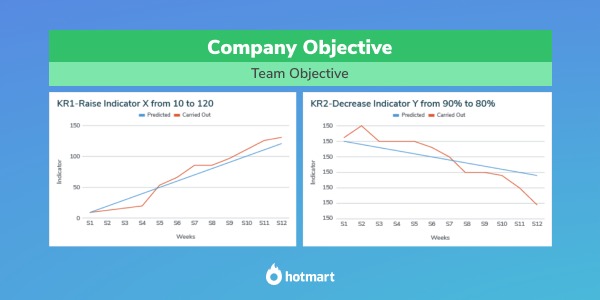
These charts are known as Burndown and Burnup, and they show whether the KR progress is above or below what is expected at that time. It is a simple way to view the plan and to make it clear to the team how the results are progressing.
The endpoint of the journey is measurement. After each cycle, it is extremely important to review the process and ensure that, in fact, it makes sense for you, your project, and your team.
Now that you are ready to implement the OKRs, let’s review the main topics before putting it into practice.
It’s time to put it into practice
The time has come for you to get your hands dirty. Creating a culture focused on results requires practice and persistence. You will make mistakes, as they are inevitable; but in the end, these are the main points you should keep an eye on:
- Do not set objective and key results per semester, year, or without a defined frequency
Results should be measured frequently for follow-up. - Your objectives should not be guided by metrics
Objectives should be inspiring and should not dictate the metrics of your KRs. - Do not set KRs as deliveries, but rather as a result
Each KR must be a result and not a task. - Don’t lose control of the progress
Measuring, following up, and communicating are extremely important to the process. - KRs must not be criteria for bonuses and performance
KRs are great tools for product growth and learning.
But learning takes place all the time, right? And you can be sure that applying the OKR methodology efficiently is a challenge for every entrepreneur. But the overall goal of this post was to make you see that guiding yourself by results is your best chance to find out if your business is on the right track.
Want to learn more and be a better digital entrepreneur while balancing your personal life? Check this blog post with tips by Billy Gene for a work/life integration.






